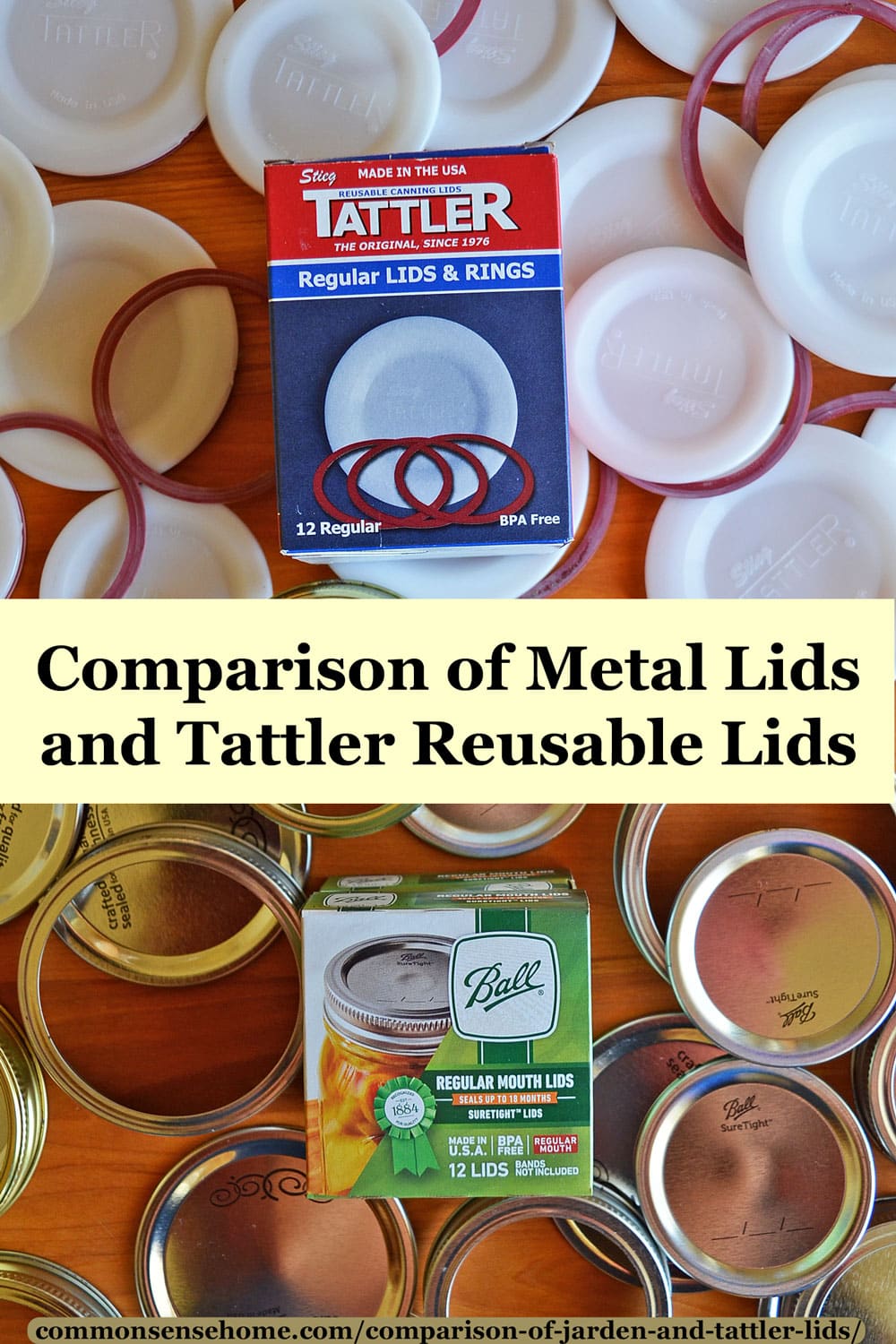
I sent email questionnaires to both Jarden and Tattler. Jarden representative Judy L. Harrold, Manager, Consumer Affairs, responded quickly. We also arranged a phone interview.
Tattler declined to comment, so I pieced together information from their website and other online sources.
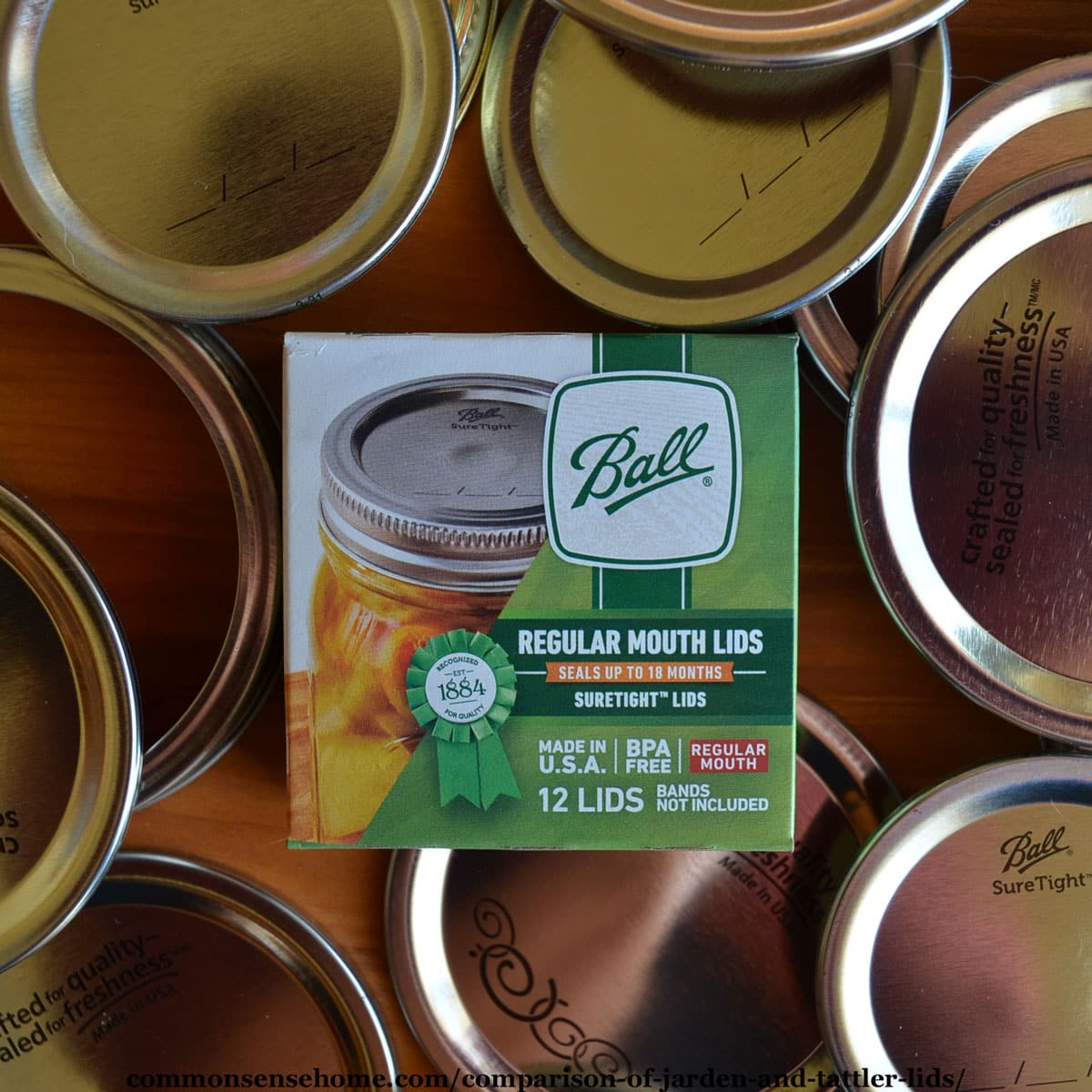
Jarden Metal Lids (Ball and Kerr brands, as well as others worldwide)
Jars and lids have been manufactured under the Ball brand name since 1885. Today, the closures are manufactured by Jarden Home Brands. Newell Brands purchased Jarden Corporation in 2016.
The two-piece caps using plastisol compound were introduced in the 1960’s and replaced two-piece caps having a latex sealing compound. All of the Jarden lids and bands are produced in their plant in Muncie, IN.
What are metal canning lids made from?
Jarden Home Brands manufacturers home canning lids using tin coated steel with an epoxy coating (to prevent corrosion) and plastisol sealant. The lids are BPA free since 2013.
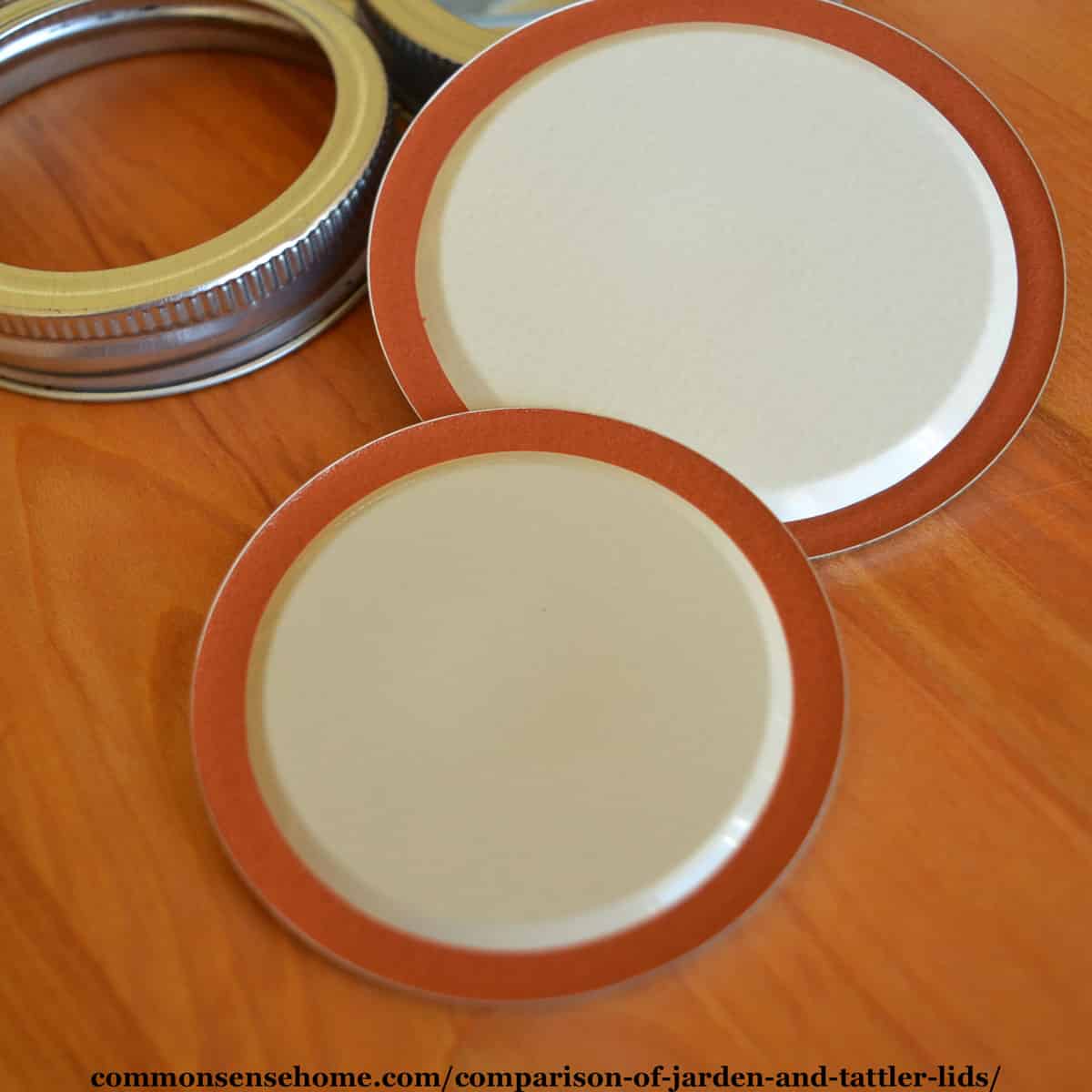
What safety testing has been done on the metal canning lids?
In-house scientists conduct ongoing quality and performance tests on bands and lids. They audit the integrity of incoming raw materials, monitor production runs against design specifications, and they conduct pack tests on the closures for shelf-life tests.
Ball brand and Kerr brand lids are used by the USDA and affiliated universities when conducting heat-penetration tests in the development of safe home canning guidelines.
Heat penetration tests were conducted by Jarden Home Brands working with university and independent authorities for the development of safe home canning recipes. Their closures stand up to this stringent testing protocol.
What support does Jarden offer to home canners?
Jarden Home Brands offers direct to consumer support services via 800#, email, Facebook, and written correspondence. We have an informative website at www.freshpreserving.com. It includes step-by-step videos, FAQs, and recipes to help the home canner experience successful results with each canning project.
Our Consumer Affairs staff has successfully completed the Better Process control School, works closely with our in-house scientists, and has nearly 50 years experience behind them.

Tattler Reusable Canning Lids
Loren Stieg, a tool and die maker, invented Tattler Reusable Canning lids in 1976, during a shortage of metal canning lids.
The Daily Sentinel shares the story:
The lids, designed for water-bath or pressure canning, are made of an injection-molded, food-grade plastic and fitted to a nitrile rubber gasket.
The name “Tattler” came about because Loren Stieg wanted them to make a sound when they sealed.
“They were going to make a noise and ‘tattle’ on themselves when they sealed,” Stieg said. “It just didn’t work that way and the design changed, but the name stayed.”
The Stiegs didn’t do much with the lids for 25 years. Then eBay and the Internet provided a willing market. This coincided with a burst of new interest in home canning and preserving.
Brad Stieg, who has a background working in materials management and logistics, decided to help his dad sell some of the inventory.
As all the lids manufactured in the 1970s started to sell out, Stieg knew he needed to start production again. The father and son incorporated in 2010 to resurrect the business.
What about Harvest Guard Reusable Canning Lids?
Harvest Guard Reusable Canning Lids was founded in 2019 by Brad Stieg, son of Tattler creator Loren Stieg.
Brad Stieg said, “I got back into the business to take care of the market the way I think it needs to be handled.”
A discussion in the Homesteading Today forum notes:
“In 2013 his son (Brad) forced a buyout, he thought he could buy out his father and run with the company that his father had built.
Loren managed to buy his son out in March of 2014 (much to his son's surprise). There was a 5 year non compete clause in the closing contract.
Approximately 5 years to the day his “son” presented and marketed Harvest Guard, a knock off of Loren Stieg's original canning lid.”
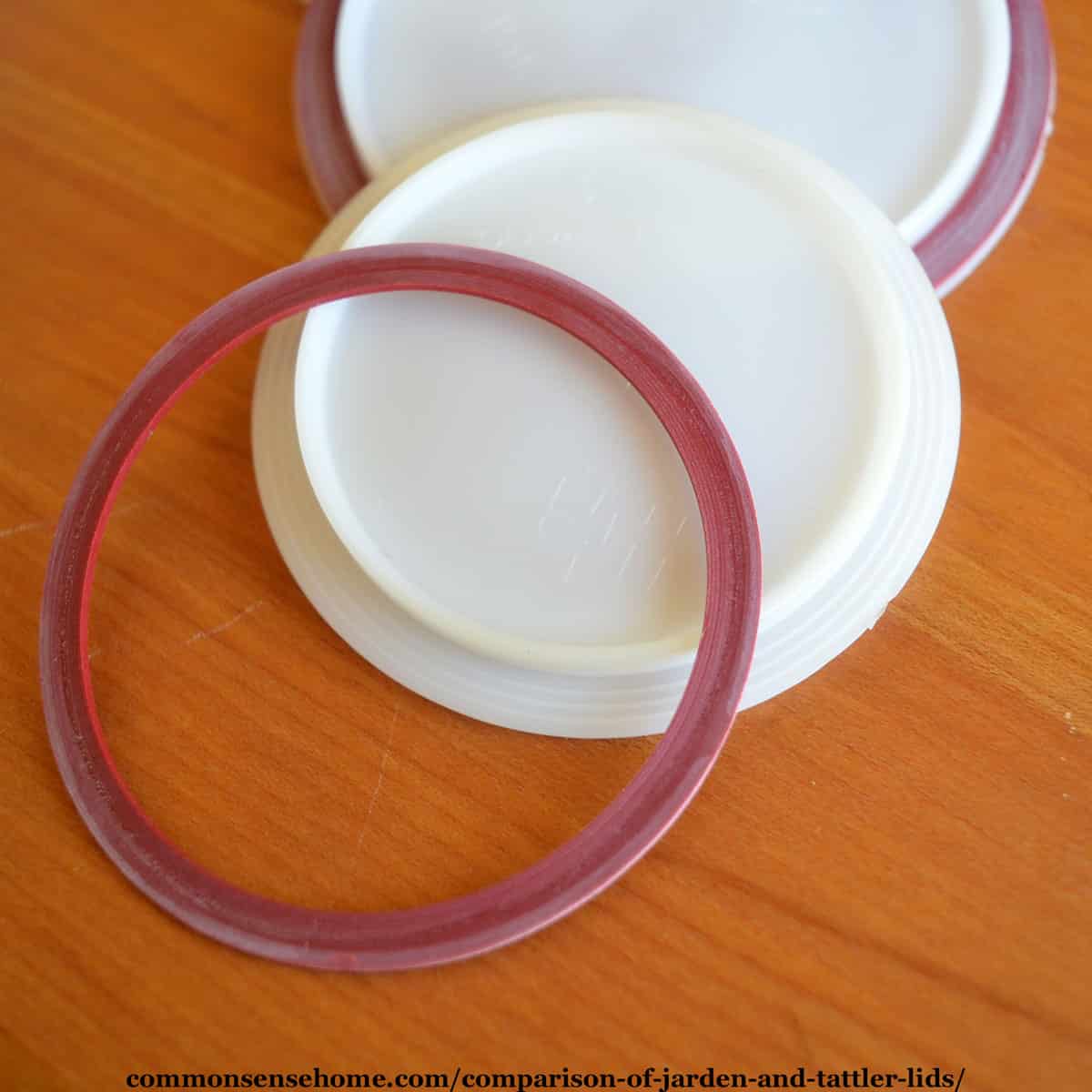
What are Tattler lids made of?
From the Tattler website: We utilize an FDA and USDA approved, food grade product known as Polyoxymethylene Copolymer (POM) or Acetal Copolymer.
The rubber rings (gaskets) are made from a food grade nitrile rubber and contain no latex.
What safety testing has been done on the lids?
From the Tattler FAQ page (now removed from the site):
Our customers state they have used the lids and rings for as many as 20 years.
Last summer (2010) we conducted a test using 14 lids and rings. The test materials were product we found in storage since 1976. They were used in both water bath and pressure canning tests over several weeks. All were reused 14 times without failure.
What support services does Tattler offer to home canners?
Tattler has a facebook page, phone number and email.
How to Use Tattler Lids
Tattler reusable lids come in wide mouth and regular lids. The plastic lids and rubber seals are used in combination with standard metal rings.
To use, prep your canning jars, inspecting for cracks and nicks.
Wash, rinse, and sterilize the mason jars. Scald the lids and rubber rings and leave them in the hot water until ready to use.
Fill jars as directed by recipe. Wipe any spills from jar rim, and screw on the lid.
From the Tattler website:
To get the correct tightness, place the jar on a counter top or other smooth surface, then place your index finger on the lid.
Tighten the ring on until the jar begins to spin on the counter top (or other smooth surface). This is the perfect tightness for processing!
Process according to safe canning guidelines.
Once the process is completed and the jars are removed from your canner, let the bubbling die down (approximately 4-5 minutes).,
Place a towel over the still hot jars (for safety) and finish tightening the metal bands. Let your jars cool naturally to room temperature.
Remove the metal band and lift the jar slightly by the lid. It should be well sealed.
Do not use Tattler lids with alcohol, strong acids, chlorine or strong sunlight. These will break down the plastic of the lids.
Concerns about Tattler Reusable Canning Lids
There are three primary concerns about Tattler Lid – formaldehyde, seal failure, and air trapped in the headspace.
Formaldehyde
The Natural Canning Resource Book notes concerns about Tattler Lids:
“Tattler lids are composed of polyoxymethlylene copolymer, an acetal copolymer. …
(The author's father, a chemist) noted that the copolymer is made from a trimer of formaldehyde called trioxane and other compound variations. Formaldehyde is a highly-toxic substance long known to be carcinogenic.
Some of the secondary additives are also potentially dangerous to human health and the environment.”
The book continues to give detailed evidence of uncombined formaldehyde in the lids.
From the Tattler website:
Many questions have been asked about the existence of formaldehyde in Acetal Copolymer. While it is true formaldehyde is present in trace amounts, research proves it is only released at very high temperatures.
Heating our brand of acetal copolymer above 460 degrees F (238 C) should be avoided.
Here is my concern:
Most of the formaldehyde is bonded and can only be released at extremely high temperatures. But could those trace amounts of unbonded formaldehyde shed into your food with normal canning use?
Risks should be minimal for home food preservation. The food inside the jar is not normally in contact with the lid.
Higher Seal Failure Rates
I noticed a significantly higher failure rate than standard canning lids, both during and after processing.
Though several studies of Tattler lids were proposed, I found results for only one.
In 2014, a University of Georgie grad student, Geetha Sivanandam, tested three types of canning lids – metal, plastic and glass. Three types of food (tomatoes, apple, and carrots) were tested under different conditions.
All three types of lids produced acceptable results, but only traditional metal lids produced 100 percent seal rate during processing and storage.
Retained Oxygen in the Headspace
Elizabeth L. Andress, Professor and Extension Food Safety Specialist from
The University of Georgia notes that there may be quality issues due to retained oxygen in headspace.
Because you finish the seal on Tattler lids when you tighten them, you don't know if all the oxygen is out of the headspace.
With metal canning lids, the vacuum creates the seal.
I suspect this was the problem with this moldy jam canned using Tattler lids.
Some sites suggest increasing headspace by 1/4 inch when canning with Tattler lids to reduce failure rates. This may increase the risk of retained oxygen.
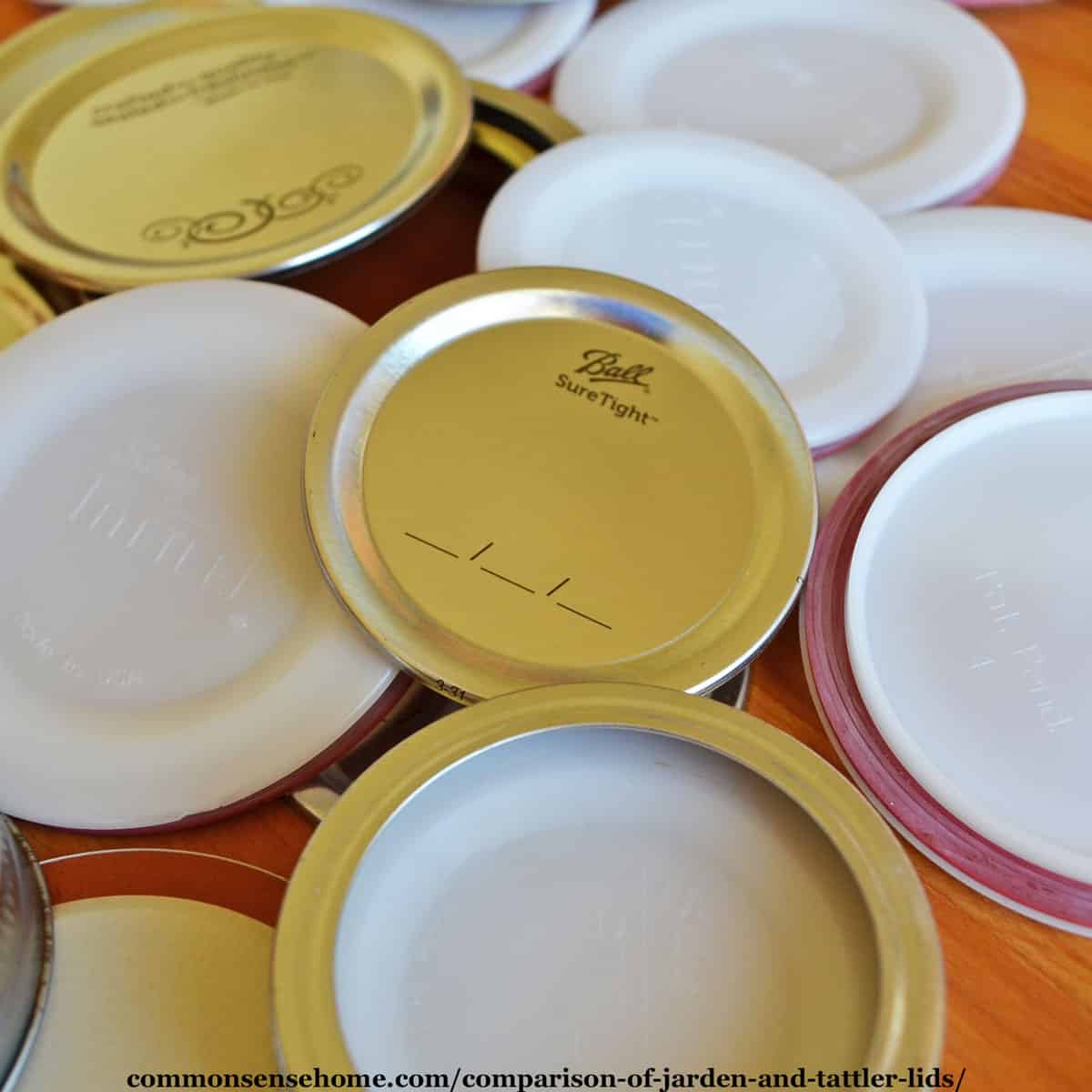
Comparison of Jarden Metal Lids and Tattler Reusable Canning Lids- Which is Better?
I prefer the metal canning lids, but many people prefer the Tattlers.
The metal lids are unmistakably sealed, and easy to use. I don't have to worry about damaging the lids when they are pried off.
If I need to leave when a pressure canner is cooling down, I know the jars will seal. I can take them out as soon as I get home, instead of waiting to screw down the lids.
I appreciate the time, money and effort spent by Jarden Home Brands on testing product safety. They also have many years of experience and a dedicated customer support team.
The primary advantage of Tattler lids is that they are reusable. They cost more upfront, but should last for many years. With standard metal lids out of stock, Tattlers and Harvest Guard may be your only choices for home canning.
You may want to practice canning some water to get the hang of using reusable canning lids.
Either lid paired with quality home canned goods is a better choice than heavily processed grocery store foods.
More on Home Food Preservation
We have dozens of recipes and home food preservation guides, all listed on the Recipes and Kitchen Tips page.
They include:
Home Food Preservation – 10 Ways to Preserve Food at Home
Botulism – Causes, Symptoms, Treatment, Tips for Safe Home Canning
How to Can Food at Home – Quick Guide to Safe Home Canning
No comments:
Post a Comment